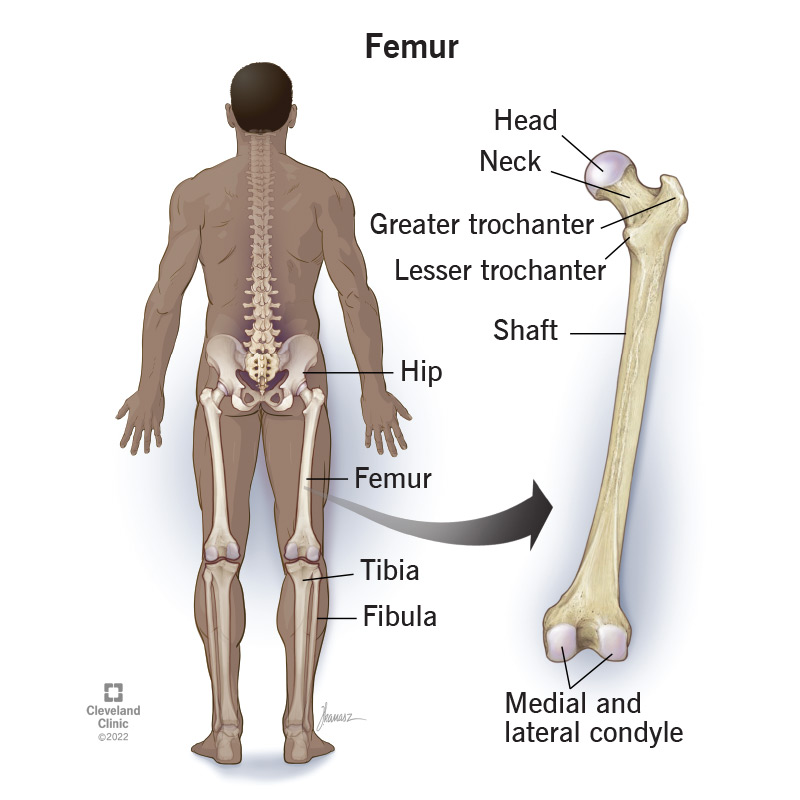The femur is the longest, strongest bone in your body. It plays an important role in how you stand, move and keep your balance. Femurs usually only break from serious traumas like car accidents. But if your bones are weakened by osteoporosis, you have an increased risk for fractures you might not even know about.
Advertisement
Cleveland Clinic is a non-profit academic medical center. Advertising on our site helps support our mission. We do not endorse non-Cleveland Clinic products or services. Policy

The femur is your thigh bone. It’s the longest, strongest bone in your body. It’s a critical part of your ability to stand and move. Your femur also supports lots of important muscles, tendons, ligaments and parts of your circulatory system.
Advertisement
Cleveland Clinic is a non-profit academic medical center. Advertising on our site helps support our mission. We do not endorse non-Cleveland Clinic products or services. Policy
Because it’s so strong, it usually takes a severe trauma like a fall or car accident to break your femur. If you do experience a fracture, you’ll likely need surgery to repair your bone and physical therapy to help you regain your strength and ability to move.
Your femur, like all bones, can be affected by osteoporosis.
Your femur has several important jobs, including:
The femur is the only bone in your thigh. It runs from your hip to your knee.
The femur has two rounded ends and a long shaft in the middle. It’s the classic shape used for bones in cartoons: A cylinder with two round bumps at each end.
Even though it’s one long bone, your femur is made up of several parts. These include:
The upper (proximal) end of your femur connects to your hip joint. The proximal end (aspect) contains the:
The shaft is the long portion of the femur that supports your weight and forms the structure of your thigh. It angles slightly toward the center of your body. The shaft of your femur includes the:
Advertisement
The lower (distal) end of your femur forms the top of your knee joint. It meets your tibia (shin) and patella (kneecap). It includes the:
All of these parts and labels are usually more for your healthcare provider to use as they describe where you’re having pain or issues. If you ever break your femur — a femoral fracture — your provider might use some of these terms to describe where your bone was damaged.
Your femur is the largest bone in your body. Most adult femurs are around 18 inches long.
The femur is also the strongest bone in your body. It can support as much as 30 times the weight of your body.
The most common issues that affect femurs are fractures, osteoporosis and patellofemoral pain syndrome.
A bone fracture is the medical term for breaking a bone. Because femurs are so strong, they’re usually only broken by serious injuries like car accidents, falls or other traumas. Symptoms of a fracture include:
Go to the emergency room right away if you’ve experienced a trauma or think you have a fracture.
Osteoporosis weakens bones, making them more susceptible to sudden and unexpected fractures. Many people don’t know they have osteoporosis until after it causes them to break a bone. There usually aren’t obvious symptoms.
Females and adults older than 50 have an increased risk of developing osteoporosis. Talk to your provider about a bone density screening that can catch osteoporosis before it causes a fracture.
Patellofemoral pain syndrome (PFPS) is pain around and under your kneecap (patella). It’s sometimes called runner’s or jumper’s knee. PFPS can be caused by everything from overusing your knees to getting new shoes. Symptoms of PFPS include:
Talk to your provider if you’re experiencing new pain in your knee.
The most common test done to check the health of your femur is a bone density test. It’s sometimes called a DEXA or DXA scan. A bone density test measures how strong your bones are with low levels of X-rays. It’s a way to measure bone loss as you age.
Advertisement
If you’ve experienced a femoral fracture your provider or surgeon might need imaging tests, including:
Usually, your femur won’t need treatment unless you’ve experienced a fracture or have been diagnosed with osteoporosis.
How your fracture is treated depends on which type it is and what caused it. You’ll need some form of immobilization, like a splint or cast, and will probably need surgery to realign (set) your bone to its correct position and secure it in place so it can heal.
Treatments for osteoporosis can include exercise, vitamin and mineral supplements and medications.
Exercise and taking supplements are usually all you’ll need to prevent osteoporosis. Your provider will help you develop a treatment plan that’s customized for you and your bone health.
Following a good eating and exercise plan and seeing your healthcare provider for regular checkups will help you maintain your bone (and overall) health. If you’re older than 50 or have a family history of osteoporosis, talk to your provider about a bone density scan.
Follow these general safety tips to reduce your risk of an injury:
Advertisement
Your femur gives you a leg to stand on, literally. It’s the biggest, strongest and one of the most important bones in your body. Talk to your provider about your osteoporosis risk. Anything you do to improve your overall health will also help keep your bones strong.
Advertisement
From sudden injuries to chronic conditions, Cleveland Clinic’s orthopaedic providers can guide you through testing, treatment and beyond.

Last reviewed on 03/11/2022.
Learn more about the Health Library and our editorial process.